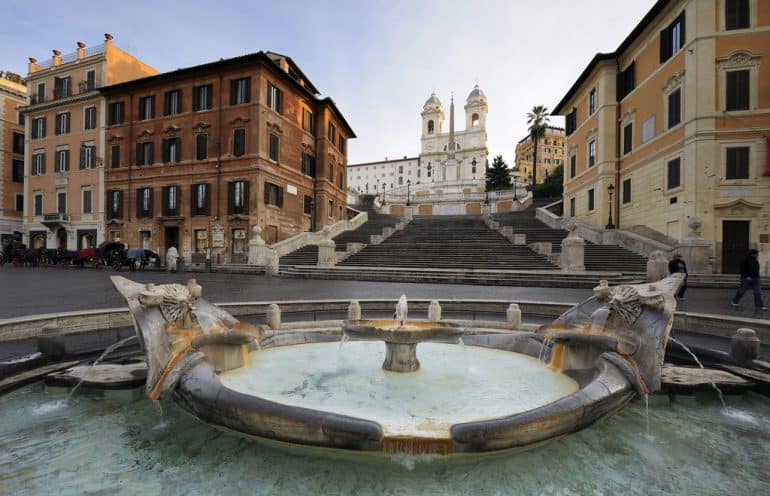
Ingeborg Bachmann – the Austrian poet and her life in Rome
When thinking about German speaking authors who lived in and wrote about Rome, the first name that comes to mind is, of course, Goethe and his Italian travels. Another writer, however, whose love for Rome left a profound mark on her literary work, and whose personal biography was closely tied to the Eternal City, is Austrian poet and author Ingeborg Bachmann (1926-1973). In an interview towards the end of her life, Bachmann stated that Rome was the place where she had learned to live. But unlike Goethe’s idealized vision of everything Italian, Bachmann focused in many of her works on the morbid side of the city and its mortality. Retracing Bachmann’s life in Rome, and seeing the Eternal City through her eyes, will allow you to get quite a different glimpse of the city.
INGEBORG BACHMANN BIOGRAPHY

Born in Austria in 1926, Ingeborg Bachmann grew up close to the Italian border; for her, Italy was a neighbour close to home, not a foreign country. After receiving a PhD in philosophy (in her thesis she basically wanted to prove Heidegger wrong), Bachmann started her literary career in Vienna. In 1954 – by then she was already an established author and had won the prestigious Gruppe 47 prize for her collection of poems Die gestundete Zeit– she moved to Rome. Struggling with her finances, she also spent some years in Germany and Austria, but always moved back to Rome as soon as she could afford it. Once, while living in Munich, she wrote to a friend that it was better to be dead in Rome than half-dead in Munich. She had difficult relationships with authors Paul Celan and Max Frisch, and the end of her relationship with the latter, with who she also shared a flat in Rome, led to severe depression and drug abuse. She died in a tragic accident in 1973, after falling asleep while smoking. She wrote essays, poems, and one novel, Malina (1971).
VIA BOCCA DI LEONE AND PIAZZA DI SPAGNA

If you want to retrace Ingeborg Bachmann’s life in Rome, you’ll have to first of all to Via Bocca di Leone 60, a small side street near Piazza di Spagna, where she lived from 1966-1971. In 2000, the city hung up a plaque to remember the Austrian writer and poet. It cites a passage from one of her essays, What I Saw and Heard in Rome (1955): “I saw that, when saying ‘Rome’, you still evoke the world, and that the key of the power are four letters S.P.Q.R.”. While living at this address, Bachmann already suffered from a severe decline in health. In order to recover, she would go on daily walks with friends, usually to Trinità dei Monti, and from there, they either went to the zoo or looked at the hydrochronometer (a kind of water clock) in the Villa Borghese gardens. The area around Piazza di Spagna was an important focal point throughout her life; she would often go to the famous Caffè Greco that has a long tradition as an important meeting place for the German speaking community in Rome.
CAMPO DE’ FIORI

Over the course of her years in Rome, Bachmann lived in eight different apartments. In 1954, when she first came to live in Rome, Bachmann took a flat in Via Ripetta 226, halfway between Piazza del Populo and the Mausoleum of Augustus. Apparently, the house was mice-infested, so she moved shortly afterwards to Piazza della Quercia 1, close to Campo de’ Fiori. Both the Campo and the statue of Giordano Bruno are hauntingly evoked in her essay What I Saw and Heard in Rome:
“I saw on the Campo de’ Fiori that Giordano Bruno is still being burned. (…) Again the smoke rises, and the flames twist in the air.”
PALAZZO CAETANI

Bachmann was incredibly adept at networking, and had many acquaintances in both the Italian and the German speaking community. After her arrival in Rome, she quickly came into contact with Marguerite Gaetani, founder of the international journal Botteghe Oscure. Published twice a year, Botteghe Oscure, which ran from 1948 to 1960, was an important international literary journal. Her poems published in this journal helped her to international success. The editorial office was located in Palazzo Caetani in Via delle Botteghe Oscure.
VIA GIULIA

In early 1972, Bachmann moved to what would be her last apartment, the Palazzo Sacchetti in Via Giulia. Due to drug abuse, her health had declined dramatically over the years. In 1973, Bachmann suffered severe burns when her nightgown caught fire from a lit cigarette. Heavily drugged, she didn’t wake up or feel any pain from the flames. She was brought to the Ospedale Sant’Eugenio, where she died about three weeks later – probably not from the burns, but due to the side effects of the drugs she had been taking. Her death was highly publicized, for days it was speculated that Bachmann had been either murdered or had tried to commit suicide.




